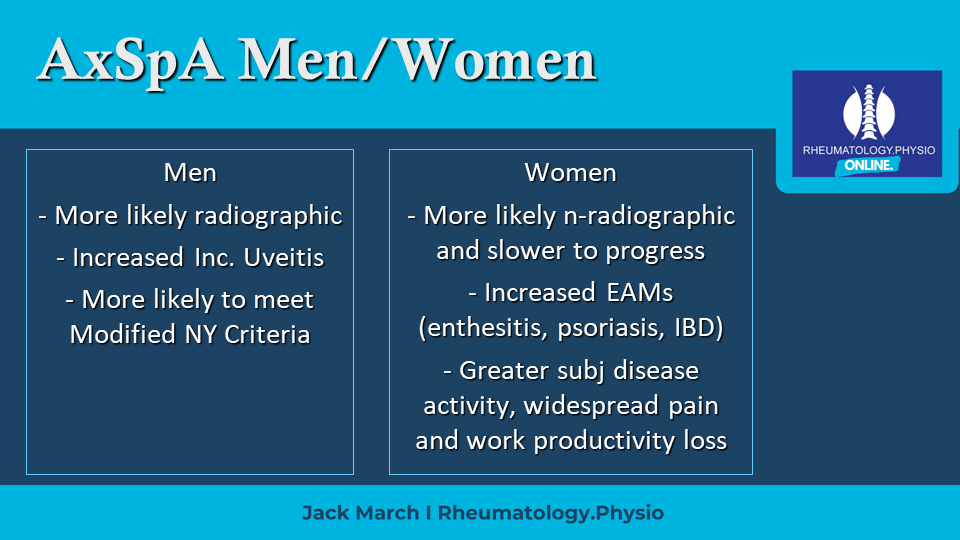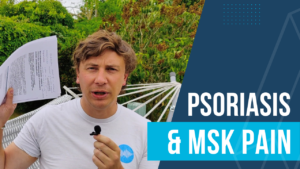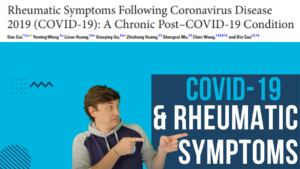On Friday 09/10/2020 I am attended a webinar by ARMA all about AxSpA in Women and how it differs to the condition in Men. This blog will attempt at summarising the differences and clinical implications for us as Therapists.
Thank you to ARMA and their invited speakers for a fascinating hour of content, they packed an incredible amount of information into it, were clear, concise and all around excellent.
I have got a few AxSpA resources available on my SHOP and an overview doc HERE. Please do consider visiting my shop and getting yourself some resources that will help you in clinic! It supports me to keep providing resources like this!
As usual feedback is greatly appreciated and any further reading for me please send it my way!
PLEASE REMEMBER – THIS BLOG IS NOT A REPLACEMENT FOR CLINICAL REASONING, IF YOU ARE UNSURE GET ADVICE
Introduction
I have summarised the main differences in this slide.

Presentation
The Modified New York Criteria is a classification criteria for AxSpA (not a diagnostic criteria) but it represents a more classical presentation of Axial Spondyloarthritis.
This means women will likely present to a health care professional with symptoms less overtly inflammatory. This coupled with an assumption that AxSpA is a disease of men is likely part responsible for the extra delay to diagnosis experienced by women (approx. 7-10 months longer than men) and the statistic that they are less often referred for specialist assessment.
Women also report more widespread pain than men, this may lead to a misdiagnosis of Fibromyalgia Syndrome (or similar) in some.
The flipside of this is that women are more likely to have Extra-Articular Manifestations (EAMs) than men (enthesitis, Inflammatory Bowel Disease, Psoriasis). When you combine this clinical picture with a less overt inflammatory pattern of back pain it is easy to see how misdiagnosis can occur. Remaining vigilant in patients attending aged <45 is vital. Holistic and multisystemic assessment is necessary.
Investigations
Women are more likely than men to be none-radiographic Axial Spondyloarthritis (nr-AxSpA), this means they do not have inflammatory changes (SIJ – sacroillitis, sclerosis, erosions or spinal enthesophytes on xrays). They are also slower to progress (if they ever do) to radiographical Axial Spondyloarthritis (r-AxSpA) than men.
Women are less likely to be HLA-B27 positive (approx. 85-90%) compared to Men (approx. 90-95%) but we need to be careful regarding different populations. One study showed a HLA-B27 positivity rate of only 50% in African Americans!
This means Xrays in women for AxSpA are essentially a waste of time, not to mention subjecting the pelvic region of younger women is a bad idea in general anyway. MRI is a much more sensitive and appropriate tool for imaging investigations. (see here for imaging info). Ultrasound scanning may well be useful to look for enthesitis in the periphery.
Blood testing is going to be helpful but interpretation needs careful interpretation. AxSpA is NOT ruled out purely by way of negative blood testing.
Response to Medications
Women have been shown to have shorter periods of time on drugs, lower treatment response and lower treatment improvement. This is multifactorial but a lack of studies in women doesn’t help as protocols are mostly designed in Men.
Onward Referral
Women with suspected AxSpA need referring to Rheumatology as do their male counterparts. We need to be highly suspicious in Women with Psoriasis and/or IBD and/or peripheral enthesitis. Key questioning around the inflammatory pattern of symptoms of both spinal and peripheral symptoms as well as family history of Psoriasis/IBD/AxSpA is an absolute necessity.
Patients with suspected (and sometimes diagnosed) Fibromyalgia are a difficult cohort to manage appropriately, we need to offset the potential negatives of over medicalising and appropriately ruling out clinical important diagnoses. In equivocal cases ultrasound of the achilles entheses might be useful to look for enthesitis.
We have access to the SPADE TOOL to assist with suspicion. Free to access and quite quick to use it will help to supplement clinical reasoning and the referral process.
Disease Outcomes
As mentioned above women are slower to progress to r-AxSpA than men but this does NOT mean the burden of disease is less. In fact it appears to be greater. Women report more widespread pain, subjectively worse disease activity and more work productivity loss.
Lets not forget the lower effects of medications for their symptoms exacerbating the issue.
End
I hope that this is found useful, remember all patients need appropriate screening and questioning. Outcomes in AxSpA are universally worse with delay to diagnosis so we need to make sure we remain vigilant.
Get me any feedback you might have so that I can grow and improve.
See you next time!


